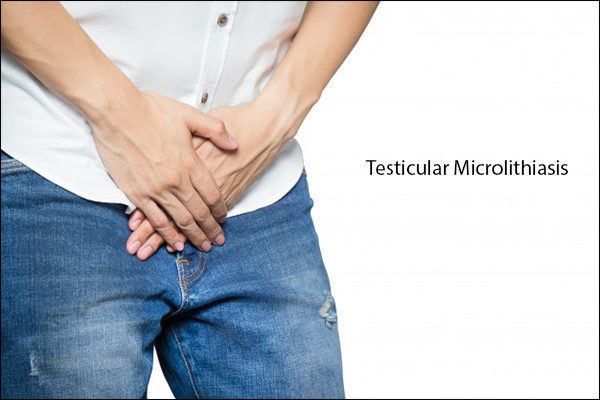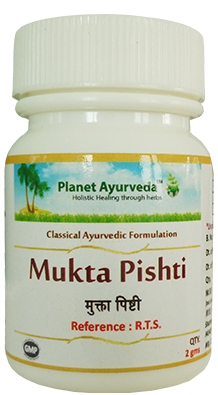Ayurvedic Treatment for Testicular Microlithiasis

Abstract
Testicles are the pair of sperm producing, oval shaped organs & main part of male reproductive system that are contained in a sac of skin called scrotum. Sometimes there is a collection of intratubular calcifications in one or both the testes which is known as Testicular Microlithiasis (TM). TM is relatively an asymptomatic condition usually found during the scanning (USG) of testes. But as this condition is associated with many benign & malignant conditions of testes, thus, can’t be ignored and must be diagnosed at early stages to get proper treatment. In this article we’re going to discuss the both, Modern & Ayurvedic view of Testicular microlithiasis side by side and its management with the best herbal products.

Introduction
Testicular microlithiasis are often numerous, uniform, tiny, echogenic multitopic calcifications within the tubules that usually don’t cast acoustic shadows. This disease of unknown etiology involves the deposition of calcium deposits in the seminiferous duct’s lumen or may have arisen from the basement membrane components of the tubules. These microliths are generally so tiny that they are impalpable, painless and asymptomatic.
Ayurvedic View
This condition is best correlated with Shukrashmarij sharkara. Shukrashmari is mentioned by different Acharyas under the types of Ashmari (urinary calculus) which are formed in the vrishna (testicles) and medhra (penis). And the concept of microlithiasis can be best correlated with sharkara mentioned by Acharaya Bagbhatta in Ashtanga Hridaya.
Causes
Exact cause of testicular microlithiasis is not known according to Modern medicine.
But in Ayurvedic Texts

(Reference- Ashtanga hridaya nidana sthana 9/15)
According to Acharyas, the suppression of the urges of semen is the basic cause of Shukrashmari. Other than that, we can consider the common causes for Ashmari (stone) formation risk factors. These are: (Reference- Charka Chikitsa 26/36)
- Not detoxifying the body at proper intervals.
- Consumption of unwholesome diet & lifestyle
- Overuse of kapha vardhak aahar vihar (kapha increasing diet & lifestyle)
Ayurvedic Samprapti of Microlithiasis (Sharkara)
After drying by Vayu and getting heat from pitta, and not achieving sufficient hardness from kapha, the ashmari (stone) breaks down into small gravel-like particles, these are known as sharkara (microlithiasis).
Sign & Symptoms
It is mostly an asymptomatic condition but there are some cases of painful testicular microlithiasis also reported. The mechanism of pain was considered due to the distention of seminiferous tubules. But it may be found in association with the cases of male infertility & testicular tumors.
Ayurvedic View
The clinical features of Shukrashmari as mentioned by Acharya Baghbhatta are:
- Pain in bladder region
- Dysuria (difficulty in urination)
- Inflammation of testicles (orchitis)
- Retention of urine
- White & soft stone (if palpable)
Diagnosis
Testicular ultrasound is the best diagnostic method. It shows the microcalcifications in both or one of the testicles. Based on the presence of these microlithiasis this condition can be categorized in 3 types:
- Limited Testicular Microlithiasis: Presence of less than 5 microliths.
- Classic Testicular Microlithiasis: Presence of 5 or more microliths (tiny calcifications).
- Diffuse Testicular Microlithiasis: Multiple tiny calcifications are seen.
Treatment
Line of management for Testicular Microlithiasis in Ayurveda includes
- Herbs rich in vata and kapha dosha quenching properties along with the use of best herbal mutravirechak (diuretics).
- Avoidance of the possible causative/risk factors that can be responsible for Shukra ashmari.
- Use of plenty of fluids orally.
- Ashmari (here Testicular Microlithiasis) in the beginning without any associated disease, is easily manageable. So the procedure like sneh karma (local massage), kshaar prayog (use of alkali preparations), kshaya prayog (use of medicated decoctions), ksheer paryog (milk use) and uttara vasti (therapeutic enema through urethral route) are recommended. (Reference– Sushrut Chikitsa 7/2)
Herbal Remedies for Testicular Microlithiasis by Planet Ayurveda
Planet Ayurveda is ayurveda based herbal manufacturing company. The product formulated here are made with strict adherence to the ancient ayurvedic texts and principles. The formulations are prepared under the guidance of our expert ayurvedic physicians and are 100% obtained from natural sources, and are made with the help of ancient time-tested formulas.
Best Herbal Remedies as suggested by our team expert’s for Testicular microlithiasis are:
- Varunadi Vati
- Boswellia Curcumin
- Kanchnaar Guggul
- Reno Plan Syrup

Product Description
1. Varunadi Vati
The classical poly herbal combination formulated in tablet form. This is one of the best herbal remedies for various stone related cases. The ingredients include the combination of best three herbs having diuretic & blood purifying actions i.e., Varun (Crataeva nurvala), Gokshur (Tribulus terrestris) and Punarnava (Boerhavia diffusa). The blood purifying action of these herbs reduces the risk of stone formation in testicles and diuretic action facilitates the passage out of micro stones through urine. Also, the fourth ingredients i.e., Guggulu (Commiphora mukul) has analgesic properties which reduce the pain in testicular microlithiasis cases.
Dosage: Two tablets twice daily with lukewarm water, after meals.
2. Boswellia Curcumin
This formulation is the best remedy suggested by our experts for any painful, inflammatory or infectious conditions available in capsule form. Boswellia Curcumin as the name describes, is made up of two ingredients Boswellia serrata (Shallaki) and Curcuma longa (Curcumin or haridra). In the case of testicular microlithiasis, the boswellia part will reduce the pain as Shallaki is well known for its analgesic properties & haridra fasten up the healing process & also reduce the risk of the infection in testicles. These both in combination will also act as a great anti-inflammatory agent, reducing swelling in inflammatory cases of this disease.
Dosage: One capsule two times a day, with plain water after meals.
3. Kanchnaar Guggul
The best-known herbal formulation for any swelling related disorders. Kanchnaar guggul is the classical formulation having 9 ingredients available in tablet form. The main ingredients include the Kachnaar (Bauhinia variegata) in combination with Guggul (Commiphora mukul) which acts as a perfect herbal anti-inflammatory agent. Also, the other ingredients such as trikatu (Piper nigrum, Piper longum and Zingiber officinale) also act as an analgesic agent aids in painful conditions also due to ushna virya (hot potency) they start dissolving these stones. And triphala (Terminalia chebula, Terminalia bellerica and Embilica officinalis) will promote the cleansing of toxins from the body which will help in reducing the recurrence of these microliths. In the end, the varun (Crataeva nurvala) will make the slow passage of the dissolved stones in an easy way.
Dosage: Two tablets twice daily with lukewarm water after meals. (Either crush or chew well the tablets for better results)
4. Reno Plan Syrup
This poly herbal syrup is formulated by Planet Ayurveda’s experts for various kidney related disorders & urinary tract infections due to the diuretic action of these multiple herbs. The main ingredient of this syrup is Bhumayamlaki (Phyllanthus niruri) which is known for its stone crushing actions, it will speed up the dissolution of these microliths and the ingredients of this syrup such as Punarnava, gokshura etc. along with Trinpanchmool Ghan will facilitate the excretion of these through urinary passage. Trinpanchmool Ghan is the 5-root extract i.e Kash (Saccharum spontaneum), Shara (Saccharum munja), Kush (Desmostachya bipinnata), Darbha (Imperata cylindrica), Ikshu (Saccharum officinarum) which are considered as the 5 best herbs for mutravirechaniya activity (i.e enhance free flow of urine), and are also beneficial in urinary tract infection which may be caused due to testicular microlithiasis. The other left constituents of the syrup such as kalmegh (Andrographis paniculata), Kaasni (Cichorium intybus), Trapush (Cucumis sativus) etc. will promote the normal functioning of the kidney that reduces the risk of further stone formations.
Dosage: Two teaspoons twice a day, after meals.
Conclusion
After reading this article you know about Testicular microlithiasis, in the modern system of medicine there is no exact treatment of this disease available. They only rely on symptomatic treatment and if the patient is presented with an asymptomatic condition only monitoring is done for any associated diseases. This will lead to formation of many complications. However, in Ayurveda, with the use of these herbal formulations the dissolution and easy removal of these microliths is possible. These herbs will not only treat the disease but also prevent the recurrence of this type of disease and other associated urinary tract infections & side by side enhancing the kidney functions.




